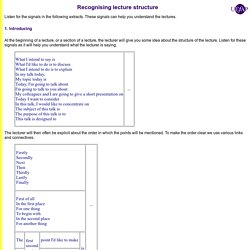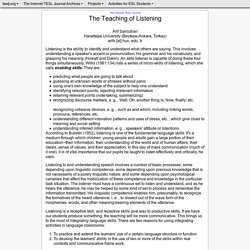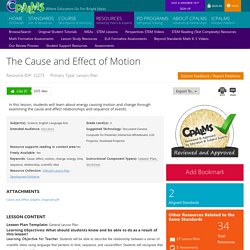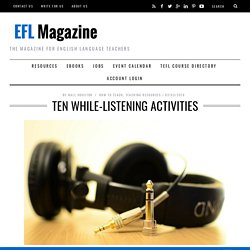

The Future of Skills. Making Inferences While Watching Videos. Purpose: to increase listening comprehension by making inferences and giving evidence to support answers to questions about a text.

Five essential listening skills for English learners. How can learners improve their listening comprehension? Teacher Raphael Ahmed shares some useful strategies in one of our top five articles of all time, illustrated by artist Jamie Johnson. Why listening is important It should not be difficult to realise the importance of listening when we consider that it occupies about 45 per cent of the time adults spend in communication. This is significantly more than speaking, which accounts for 30 per cent, and reading and writing, which make up 16 per cent and nine per cent respectively. Yet, for all its importance, students (and even teachers) often fail to give listening the attention it needs.
Listening challenges for English language learners. Listening skills: Guide. By Miles Craven A short, handy guide to the skills students need to practice to become better listeners.

Listening in a foreign language is a complex process. Students have to be able to understand the main idea of what is said, as well as specific details. They may need to check any predictions they have made, and understand the speaker’s meaning, emotions and opinions. They may have to infer relationships between speakers, or identify the context in which the speakers are operating. Here are some of the main skills involved in listening, together with a brief description of what each skill involves.
Making Inferences - TESOL Planner. Sequence of Events: Lesson for Kids - Video & Lesson Transcript. Buscar. New Digital Citizenship Standards Alignment (2019) Five essential listening skills for English learners. Listening skills practice: comprehension exercises - level B1. Intermediate B1 listening. Listening skills practice: comprehension exercises - beginner level A1. EAP Listening - Structure. Listen for the signals in the following extracts.

These signals can help you understand the lectures. 1. Introducing At the beginning of a lecture, or a section of a lecture, the lecturer will give you some idea about the structure of the lecture. Listen for these signals as it will help you understand what the lecturer is saying. The lecturer will then often be explicit about the order in which the points will be mentioned.
Listen to the following talks and identify phrases the same as, or similar to, the ones given above: Saricoban - The Teaching of Listening. The Internet TESL Journal Arif SaricobanHacettepe University (Beytepe-Ankara, Turkey)arifs [at] hun. edu. tr Listening is the ability to identify and understand what others are saying.

This involves understanding a speaker's accent or pronunciation, his grammar and his vocabulary, and grasping his meaning (Howatt and Dakin). An able listener is capable of doing these four things simultaneously. Saricoban - The Teaching of Listening. English Listening Comprehension Exercises - Ejercicios de comprensión auditiva de inglés - Para aprender o practicar inglés. Just like atmospheric conditions can affect weather on the ground, experts say the sun is responsible for weather in They say the Sun's atmosphere emits high energy solar winds that the Earth continuously with electromagnetic energy.

Nicola Fox is with the Johns Hopkins University Applied Physics Laboratory in Laurel, Maryland. "You could really think of it as us living in the atmosphere of the Sun," Fox explained. "So, if the Sun changes, the Earth will feel its effects. . , the Earth will catch a cold. " But until now, space scientists have been unable to the source of energy releases in the earth's atmosphere that are responsible for the spectacular light show, aurora borealis, in the extreme northern and southern latitudes. Deducing meaning from context – The Portable TEFList. Let’s start off with Ferdinand de Saussure’s second favourite Youtube clip (he details his favourite videos in in his seminal paper Les Clips, Le Signifié et Le Signifiant: Quelque Chose que Je Viens d’Inventer (unpublished), page 3).

Your pre-listening/watching task is to find it amusing. So, why would I be sharing this with you? The reason is to talk about how you make sense of it. After all, the humour is based on, among other things, some excellent neologisms, so there’s a lot going on when you process what Blackadder says (for the purposes of this post, let’s pretend there was no video and this is an extract from a reading lesson). Here’s the transcript (the reading text) from 49 seconds in: Dr. High Stakes Testing: The Impact on English Language Teachers in Hong Kong. The Cause and Effect of Motion In this lesson, students will learn about energy causing motion and c ... Lesson Plan Template: General Lesson Plan Learning Objectives: What should students know and be able to do as a result of this lesson?

Learning Objective for Teacher: Students will be able to describe the relationship between a series of scientific ideas using language that pertains to time, sequence, and cause/effect. Students will recognize that energy has the ability to cause motion or create change.Student Friendly Objective: I will be able to find how events in scientific ideas have a certain order and can cause certain things to happen. As a result of my learning, I will know that scientific ideas can be described in cause and effect, sequence, and time order relationships. Five essential listening skills for English learners. Listen A Minute: Easier English Listening and Lesson Plans. Ten while listening activities. Ten While-Listening Activities This is the third in a series.

The first part is ‘The Three Stages Of A Listening Activity.’ The second is ‘Ten Pre-Listening Activities.’ This time, I’m going to describe ten activities that can be used while students are listening to a text. It’s important to set a task for the while-listening stage, so that students are actively involved and have something to focus on as they listen. I suggest using 3 or 4 of the activities below.
Everyday conversations: Women's leadership [audio] Six students from around the world meet.
![Everyday conversations: Women's leadership [audio]](http://cdn.pearltrees.com/s/pic/th/conversations-leadership-120491183)
What do they have in common? They are all exchange students studying at a U.S. university for a semester. Throughout the semester, they learn more English, learn about U.S. culture, and learn more about their fields of study. Ten while listening activities. Register and degrees of formality. All cultures seem to have concepts of formality, what can be confusing is that these concepts differ from culture to culture.

Brexit Tutor Time by EC_Resources. PART 3 - PET SPEAKING, SET OF IMAGES - CAMBRIDGE PRELIMINARY CERTIFICATE IN ENGLISH. Examiner: I would like you to look at the photograph and talk about it. Student A: This image shows a group of young people enjoying the sport of rafting. Enseñanza de las lenguas: Un enfoque centrado en la acción. Informe de satisfacción de familias CEOM 2016 by CEOM Asociacion para la integracion de los. Curso de Conversación de Inglés para Negocios en Lima Perú - Business English Conversation in Lima.
Sesiones de Aprendizaje versión 2016. Sesiones de inglés de contingencia 2019. American English Webinars. AE Live 4.2: Assess and Motivate: Student Portfolios and Self-Assessments in the EFL Classroom. Portfolios in ELT. A brief history of European Language PortfoliosWhat are Language Portfolios? Advantages of using themThe problems with Language PortfoliosUsing Language Portfolios with young learners A brief history of European Language PortfoliosTeachers and learners have been working with Language Portfolios since the mid 1990s, and between 1998 and 2000 various ELP models were piloted in Europe. There has been much literature written about them and there are lots of interesting examples. In the year 2001, which was also the European Year of Languages, The Council of Europe launched ELPs throughout Europe.
Programación o planificación curricular 2019. Clil Science: enseñando ciencias en inglés. Universidad de Navarra. Links - MLTAV CLIL Teachers' Network. Article 2 - Vol 1 (4) 2012 - International CLIL Research Journal. Wolfgang Zydatiß Freie Universität Berlin Abstract The article summarises some important findings of an evaluation project on extensive bilingual courses set at grammar schools in Berlin (using English as the working language). It focuses on interdependencies between foreign language competencies and academic discourse competencies relevant to subject-matter teaching at the lower secondary level. Employing a comparative design, the study relates the performance of two pupil-samples; one taken from regular classes (taught in German) and one drawn from bilingual streams at the same schools. Both groups of students underwent an English achievement & proficiency test plus a test (in either German or English) probing learners’ subject-matter literacy pertaining to different curricular areas.
Keywords: CLIL, bilingual education, threshold hypothesis, task-based language assessment, bilingualer Sachfachunterricht, general academic (second / foreign) language proficiency. Evaluacion desempeño curriculo 2018. Professor Lynda Taylor - Centre for Research in English Language Learning and Assessment (CRELLA) A Venezuelan Refugee Crisis. Speaking & Listening » Grade 6. Comprehension and Collaboration: CCSS.ELA-Literacy.SL.6.1Engage effectively in a range of collaborative discussions (one-on-one, in groups, and teacher-led) with diverse partners on grade 6 topics, texts, and issues, building on others' ideas and expressing their own clearly.
CCSS.ELA-Literacy.SL.6.1.aCome to discussions prepared, having read or studied required material; explicitly draw on that preparation by referring to evidence on the topic, text, or issue to probe and reflect on ideas under discussion. CCSS.ELA-Literacy.SL.6.1.bFollow rules for collegial discussions, set specific goals and deadlines, and define individual roles as needed.
CCSS.ELA-Literacy.SL.6.1.cPose and respond to specific questions with elaboration and detail by making comments that contribute to the topic, text, or issue under discussion. English Language Arts (ELA) Important Information for Parents - What is E.L.A.? Leslie Selcer - Teaching Portfolio. Future forms. We have different ways of talking about the future. We often use going to (+ infinitive), the present continuous (to be + -ing) or will (+ infinitive). The structure we use depends on the function of what we want to say, whether we are talking about arrangements, plans, predictions, etc.. I thought will was the future tense in English. Project Management. Escuela de Negocios - EOI Escuela de Organización Industrial. Project Management for Middle School. Foundry. Getting Smart - Innovations in Learning - Getting Smart. Intel Teach Elements: Project-Based Approaches. PBL21 - 21st Century Schools
Premier TEFL/TESOL Certification Courses. Bridge TEFL is a division of Bridge Education Group, an accredited educational institution listed in the U.S. Department of Education Database of Accredited Postsecondary Institutions and Programs. Bridge Education Group has over 30 years’ experience in the field of international education (read our story), with centers in the U.S. and South America.
In addition to our TEFL division, which offers teacher training, we also have five other divisions, offering a range of educational services: Bridge in Denver offers TEFL certification, language classes and testing, and translation services. Bridge in Denver offers TEFL certification, language classes and testing, and translation services.
BridgePathways offer an intensive Academic English Program on the campus of Colorado Mesa University. WEBINAR: Los aprendizajes a desarrollar en el Currículo Nacional. Activate teaching-pet-for-schools-listening. Planificación curricular 2017. Planificación Curricular Unidad didáctica Comunicación. Procesos pedagógicos: sesión de aprendizaje. PROCESOS PEDAGOGICOS Y DIDACTICOS DE UNA SESION DE APRENDIZAJE. Procesos pedagogicos y procesos didacticos por areas curriculares. CURRÍCULO NACIONAL2017. CURRICULO NACIONAL 2017 EN WORD. Sesión de aprendizaje 2017.docx. PROGRAMACIÓN CURRICULAR - PROGRAMACIÓN ANUAL - UNIDADES DIDACTICAS - SESIONES DE APRENDIZAJE.